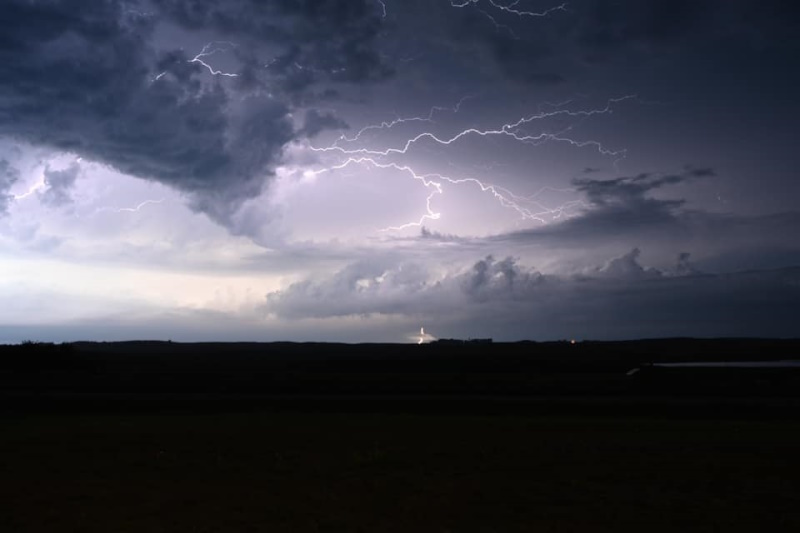Weather Modification
Cloud seeding is a weather modification technique generally employed to enhance precipitation or reduce hail. Cloud seeding entails releasing small particles into clouds to affect their development. Supercooled clouds (clouds with droplets at a temperature below 0 ºC) can be seeded with ice nuclei, such as silver iodide. The introduction of silver iodide into supercooled cloud regions by aircraft creates ice crystals (snow), which enhance the efficiency of precipitation production. Ice particles quickly grow in mixed-phase clouds at the expense of water droplets, obtaining sizes large enough to fall, pass into warm air, melt, and land as rain drops. The ice nuclei that typically occur naturally in the atmosphere only produce ice at cold temperatures (< -15 to -25 ºC), while cloud seeding can produce ice in warmer (-5 to -15 ºC) supercooled clouds. Production of ice at warmer temperatures increases the precipitation production efficiency of clouds, which is similar to how educated workers improve the efficiency of a factory.
UND Faculty Researchers: David Delene, Marwa Majdi
Improving North Dakota Thunderstorm Forecasting using Machine Learning Neural Network
The project will focus on enhancing the short-term forecasting of atmospheric instability, a critical factor in the formation of thunderstorms that can lead to severe weather conditions. Accurate forecasting is essential for the North Dakota Cloud Modification Project (NDCMP), which operates every summer in western North Dakota to mitigate hail damage and enhance rainfall. Reliable weather predictions are vital for anticipating the development of thunderstorms, a task that presents significant challenges. UND has collaborated with NDARB for 20+ years on numerous projects to address these forecasting needs, utilizing mesoscale numerical weather prediction models to support the NDCMP's cloud seeding initiatives.
Contact: Marwa Majdi
News Articles

Severe Thunderstorm in Lehr, ND on August 1st, 2023 (Courtesy of Shelly Glaesman)
Summer and Fall 2023 Saudi Arabia Field Project and Analysis (Spring 2024 Extension I)
The University of North Dakota is supporting the Saudi Aerosol-Cloud-Precipitation Enhancement Campaign (SARPEC) series of field projects, which aims to determine the effectiveness of operational cloud seeding techniques for rainfall augmentation within the arid climates of the Kingdom of Saudi Arabia. The first SARPEC intensive operational period (IOP) occurred in the late summer of 2023 coincident with the seasonal monsoon of the Asir mountains/escarpment of southwest Saudi Arabia. In-situ measurements of cloud microphysics properties were obtained using the North Dakota Citation Research Aircraft, which deployed cloud probes and airborne wind measurements systems. Twelve research flights were conducted during the summer of 2023, which included five cloud physics missions. Cloud penetrations were conduced at various levels (-10 °C, -15 °C, -20 °C) above cloud base to determine how liquid water content properties vary with vertical development and to observe the effects of ice crystal aggregation processes. A second SARPEC IOP was conducted in October/November of 2023, with 21 flights completed. A third SARPEC IOP was conducted from March 16 to April 26, 2024 (Extension I) with 15 flights completed. Analysis data from the SARPEC IOP were presented at national and international conferences. Initially three peer-reviewed Journal Articles are planned: 1) Saudi Aerosol-Cloud-Precipitation Enhancement Campaign (SARPeC) - Motivation, Science and Operations: Successful Dual Aircraft Convective Cloud Penetrations, 2) Observations of Wind Flow Related to Thunderstorm Genesis Along the Red Sea Escarpment of Saudi Arabia, and 3) Cloud Observations and Processes in Saudi Arabia Convective Clouds
Contact: David Delene
News Articles
Media
The following video shows what a typical research flight is like.

This photo, taken in 2023, captures the UND Department of Atmospheric Sciences team's view as they conduct weather modification research while flying into clouds over or near Saudi Arabia.